MARIANI’SVirtual
Gourmet
June
22, 2014
NEWSLETTER
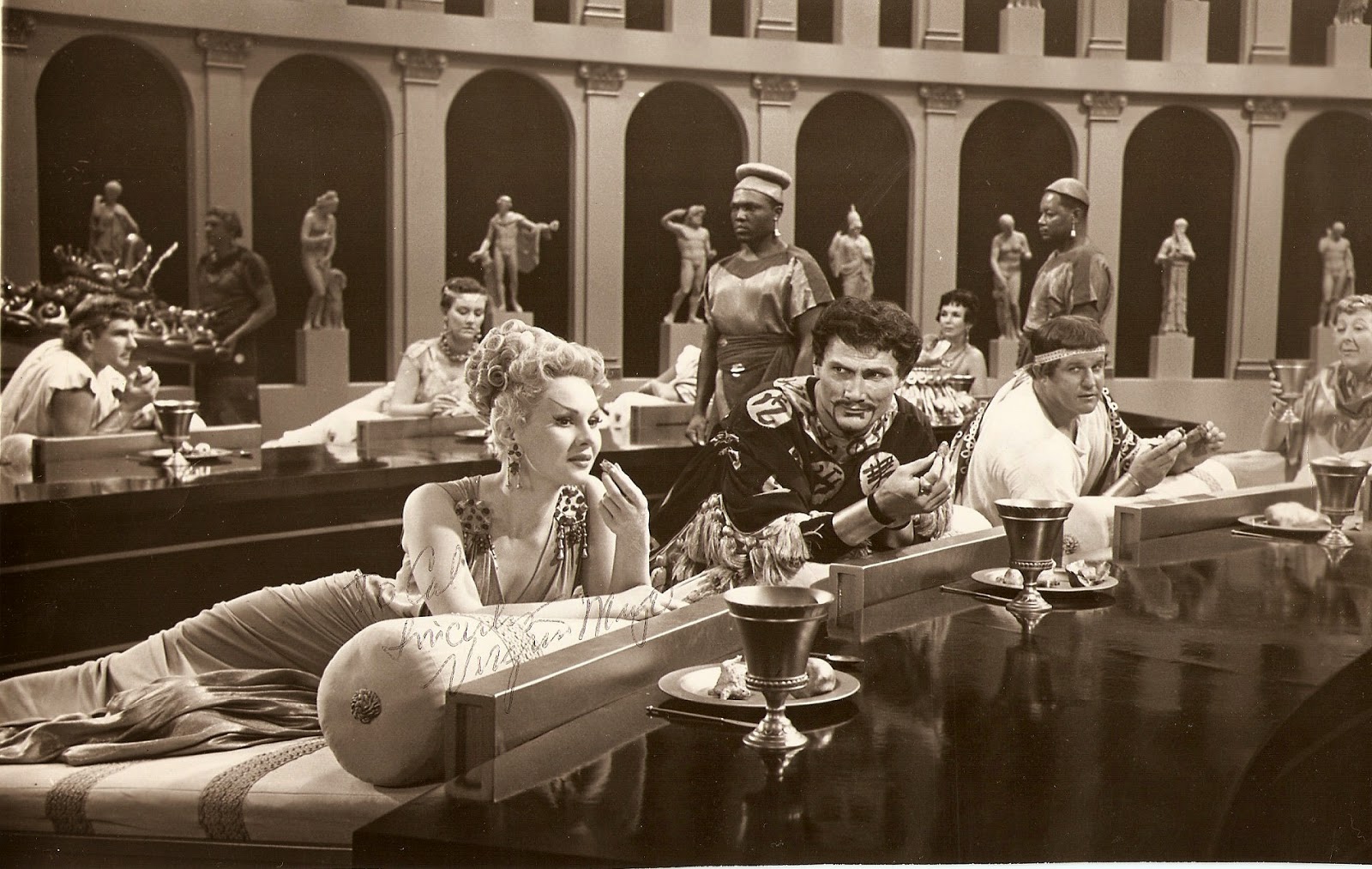
Virginia Mayo
and Jack Palance in "The Silver Chalice"
(1954)
❖❖❖
IN THIS ISSUE
SUMMER READING
By John Mariani
NEW YORK CORNER
TELEPAN
By John Mariani
NOTES FROM THE WINE CELLAR
By Mort Hochstein
❖❖❖
SUMMER READING
By John Mariani

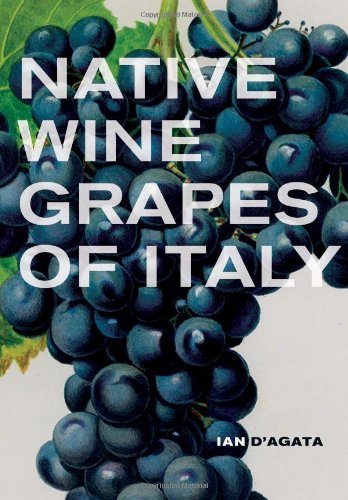
Native Wine
Grapes of Italy by Ian
D'Agata (University of California Press)--No one
knows more about Italian wine that Ian D'Agata,
whose training as a physician has caused him to
turn a prognostic eye on the vast number of wine
grapes found from Alto-Adige to Sicily. It
is easily the most comprehensive volume on the
subject--ever--and promises to be so for years
to come. In the case of each
varietal, based both on ampellograpy and
tastings, D'Agata gives a complete description
and history coupled with "Which Wines to Try and
Why." And he skimps on nothing: a relatively
unknown grape like Bombino or Nascetta gets as
thorough an entry as one on Primitivo or
Canaiolo Nero. You also get to meet the
people from small estates who make the best of
the varietals. At 620 pages, there's little
anyone could possibly want to find out about
Italian viticulture and viniculture that isn't
here. It is a magnum opus of daunting authority
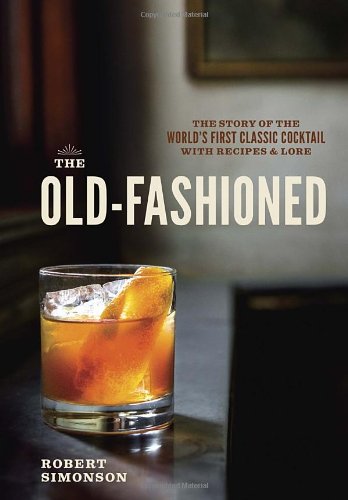 The Old-Fashioned
by Robert Simonson (Ten Speed Press)--Usually
I'm not much impressed by 168-page single
subject books, but Robert Simonson is such an
engaging author that he makes this the perfect
book to accompany an easy chair and a well-made
Old-Fashioned cocktail. Fully 65 pages of
the book are meant for that--an incisive,
impeccably researched story of this too often
forgotten classic cocktail, resulting in some
good rollicking stories that American history is
rich in. He takes you back to the 19th
century, to Chicago during Prohibition, and the
drink's "Postwar Heyday," when the New Yorker Magazine
declare the drink "a national
institution." Following are dozens of
recipes and variations, all of it well packaged
in a small size with fine illustrations.
The Old-Fashioned
by Robert Simonson (Ten Speed Press)--Usually
I'm not much impressed by 168-page single
subject books, but Robert Simonson is such an
engaging author that he makes this the perfect
book to accompany an easy chair and a well-made
Old-Fashioned cocktail. Fully 65 pages of
the book are meant for that--an incisive,
impeccably researched story of this too often
forgotten classic cocktail, resulting in some
good rollicking stories that American history is
rich in. He takes you back to the 19th
century, to Chicago during Prohibition, and the
drink's "Postwar Heyday," when the New Yorker Magazine
declare the drink "a national
institution." Following are dozens of
recipes and variations, all of it well packaged
in a small size with fine illustrations.
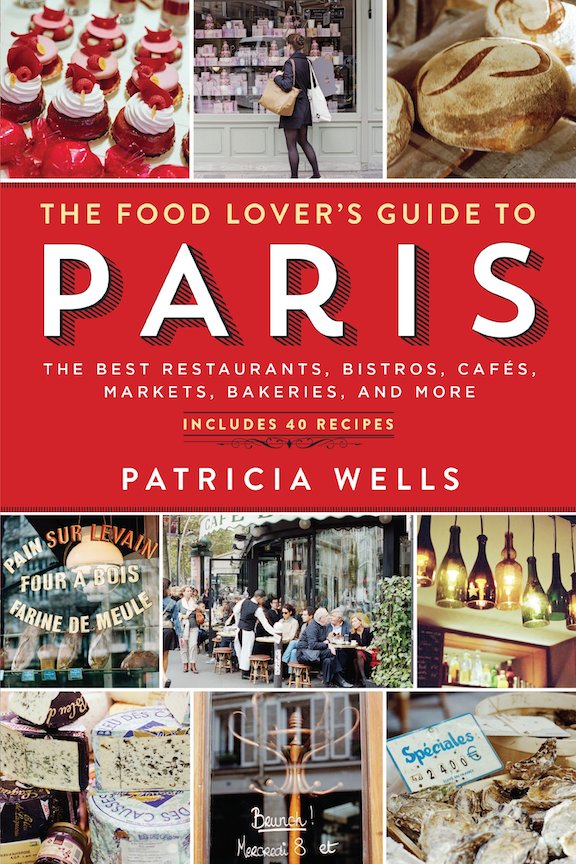
The Food
Lover's Guide to Paris: The Best Restaurants,
Bistros, Cafés, Markets, Bakeries, and
More by Patricia Wells
(Workman Publishing Company)--Way back in
1984 Patricia Wells published the first edition
of this requisite guide to Parisian gastronomy,
not just to the Michelin-style restaurants and
famous bistros but to her personal favorites
among bakeries, chocolate shops, cheese stores
and boulangeries. Now, 30 years later, she has
completely revised her classic, and this new
book shows just how much the Paris food
scene has and has not changed in all that time.
"Many chefs have come and gone," she
writes. "Others have matured into
excellence. And, most exciting, I have had
the pleasure of covering the new group of
energetic young cooks who are expanding the
culinary `musts' into up-and-coming Paris
neighborhoods." You'll still find some old
favorites, like Le Duc and Au Trou Gascon,
updated along with new listings for new places
like L'Atélier de L'Éclair and
Albion, and Wells shows just how international
Paris has become with good Italian, Thai,
Chinese and other ethnic restaurants and
eateries.
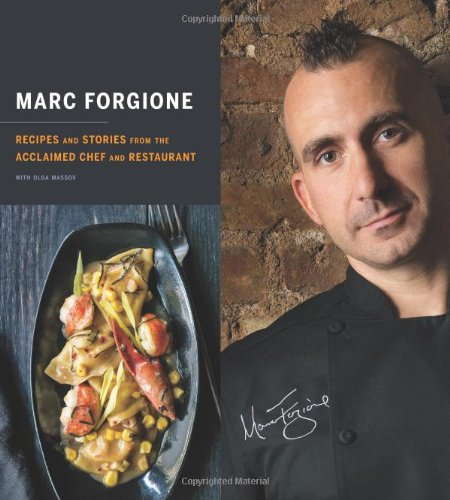
Marc Forgione:
Recipes and Stories from the Acclaimed Chef and
Restaurant by Marc Forgione
(Houghton Mifflin Harcourt)--No chef has ever been
prouder of his pedigree than Marc Forgione, whose
father Lawrence, was a pioneer of what was called
the New American Cuisine of the 1980s. That
Marc has distinguished himself by building on his
legacy is evident on every page of this splendid
new book, three years in the making. He has
some good stories along the path to opening his
restaurant--including the time he unknowingly
threw out a reporter from the NY Times-- then
proceeds with a great deal of technique lessons in
order to get the beginner to attempt dishes like
his cuttlefish with papas bravas, chorizo and
spicy mayonnaise and suckling pig face with
mustard and pickles. There's a good section on
cheeses and cocktails, too.
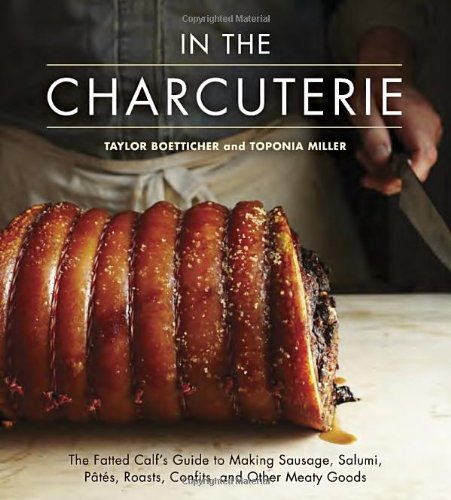
In The Charcuterie: The Fatted Calf's
Guide to Making Sausage, Salumi,
Pâtés, Roasts, Confits, and Other
Meaty Goods by Taylor
Boetticher (Ten Speed Press)--There
have been several charcuterie books that have come
out in the past few years, but this is easily the
most authoritative and clear in its approach to a
kind of food many people are fearful of trying at
home. For a dish like the duck and lemongrass
sausage patties alone, this book would be
worthwhile, as for the pork bollito misto and the
rabbit porchetta, which expand the usual
repertoire of charcuterie. Some dishes are
relatively simple, others take some doing and long
prep, but everyone of them is packed with enormous
flavor, and the instruction have been carefully
edited for maximum ease.
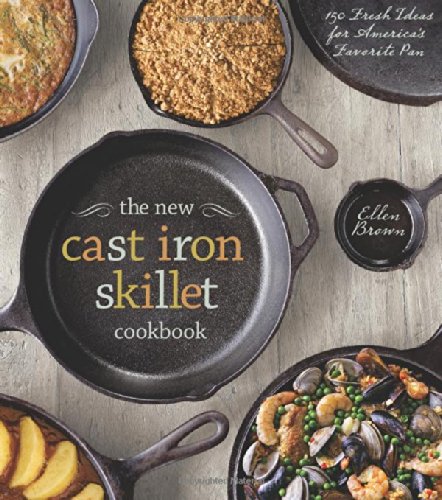
The New Cast
Iron Skillet Cookbook: 150 Fresh Ideas for
America's Favorite Pan by
Ellen Brown (Sterling Epicure)--There
have also been a few cast iron skillet books out
recently, so that it has almost become a genre of
its own. The superiority and
versatility of cooking on well-used, well-seasoned
cast iron, which is very much in the American, not
European, tradition should be unquestioned after
paging through a volume that makes perfect sense
out of using the utensil for everything from basic
steaks and burgers to Rhode Island clam cakes,
Vietnamese spring rolls, Cajun halibut, an a
marvelous array of upside-down cakes. I
doubt many cooks anywhere have the depth and
breadth of Ellen Brown, who in her career has
written books on everything from wraps to
gluten-free breads. I'd trust her to cook a
shoe for Charlie Chaplin and have him gobble it up
with pleasure.
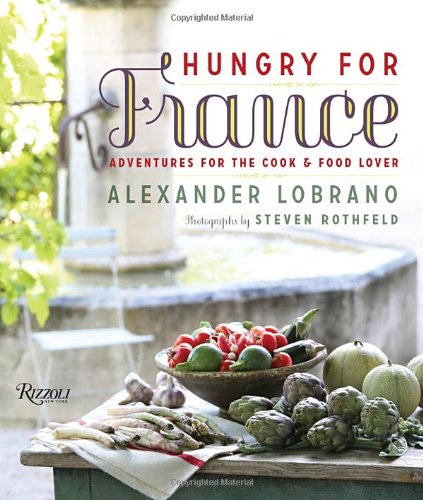
Hungry for France by Alexander Lobrano (Rizzoli)--I've long believed Alexander Lobrano, who's lived in Paris for 30 years, is the finest chronicler of all that goes on in French cuisine today. His enthusiasm alone makes reading him pure joy, and here he covers the different regions of France and its sprawling diversity of styles, from an Alsatian tarte flambé to from a Provençal ratatouille gratin. Lobrano starts each section telling you about the region's best cooks and restaurants, largely favoring bistros with delightful names like Youpla, Au Chapeau Rouge, Les Glazicks, and Ttotta, accompanied by a fine series of evocative photos by Steven Rothfield. It's good to have a dining partner like Lobrano who writes, "To be sure, some people have been kicking France's ankles in a double-decade take-down of Gallic gastronomic superiority. But the wonderful news is that they're all more wrong than right. I defy you to find another country anywhere in the world where you can so reliably find a spectacular meal--at all levels of the food chain--in it most remote and forgotten villages.
❖❖❖
The rich
variety and quality of restaurants on the Upper
West Side, now all the way up through Harlem,
increases about as consistently as the trendy
restaurants that close each month on the Lower
East Side and in Brooklyn. From
the newly opened Tavern on the Green (reviewed
last week) and Cecil’s to the well-established Bar
Boulud, Lincoln Ristorante, Shun Lee Café,
The Leopard at Des Artistes and Picholine, the
West Side is as solid as any other section of the
city in good restaurants. Among
the latter is Telepan, Bill Telepan’s
exceptionally friendly restaurant that opened ten
years ago near Lincoln Center.
Telepan (below) had learned his craft at
the three-star Alain Chapel near Lyons, then, back I
the USA, at Le Cirque, Le Bernardin and Gotham Bar
& Grill in New York, making his own rep at
Judson Grill.
(He also has a new casual TriBeCa eatery
named Telepan Local.)
With the kind of training he’s had, his
grounding in French haute cuisine has made him one
of the city’s most respected chefs, and his
diligence has paid off with an intensely loyal
crowd.
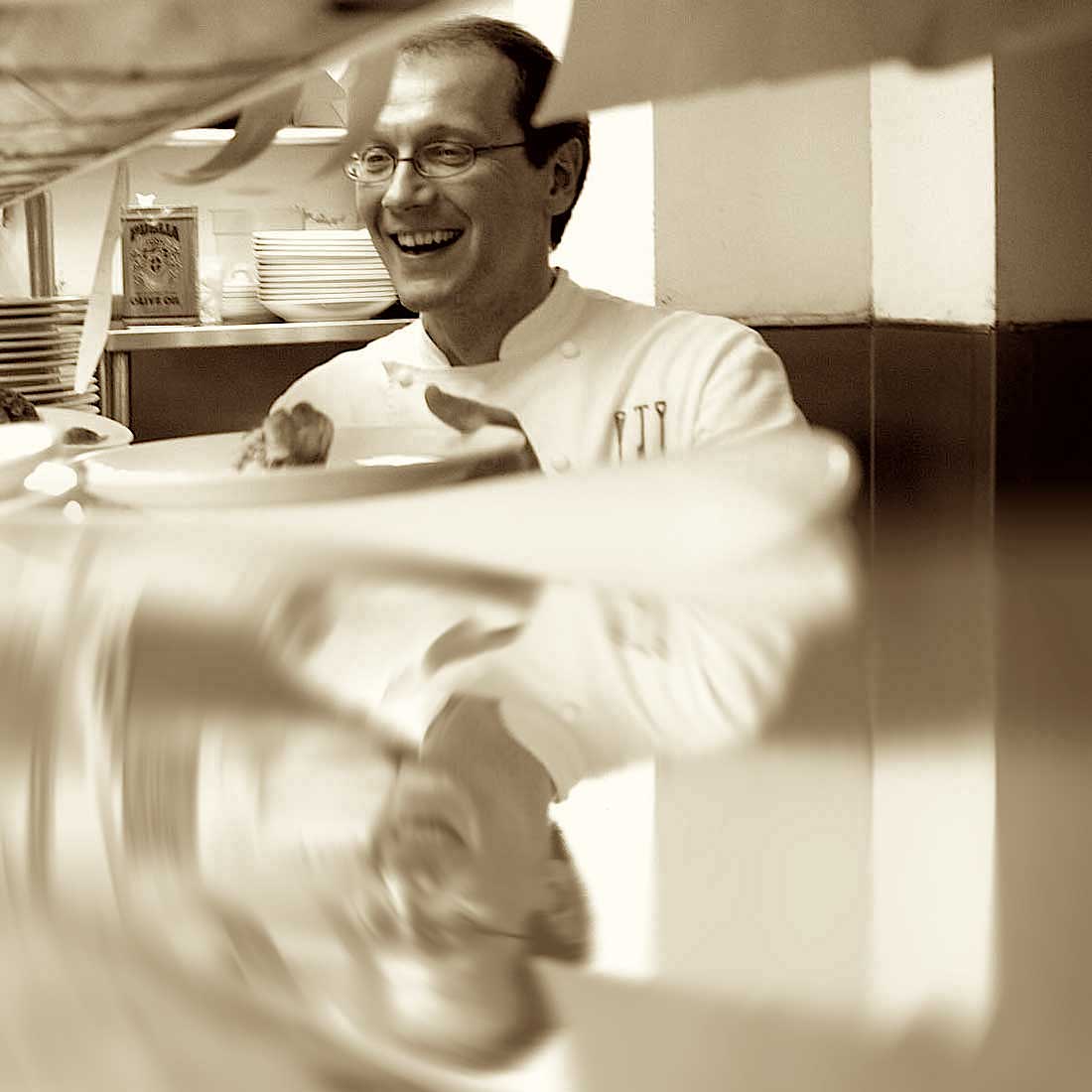 The two dining rooms could
hardly be lovelier, the summery pale green walls, light wood
floors, white tablecloths and wall-sized artwork of
ripe fruits all work with the convivial lighting of
the place (though for some reason, around 8 PM
someone unnecessarily flicks on a dimmer) to buoy
people’s spirits, and the sound level is very
civilized for conversation. Waiters are nicely
dressed, the greeting at the door is cheery, and the
pacing of the meal is calmly professional.
The two dining rooms could
hardly be lovelier, the summery pale green walls, light wood
floors, white tablecloths and wall-sized artwork of
ripe fruits all work with the convivial lighting of
the place (though for some reason, around 8 PM
someone unnecessarily flicks on a dimmer) to buoy
people’s spirits, and the sound level is very
civilized for conversation. Waiters are nicely
dressed, the greeting at the door is cheery, and the
pacing of the meal is calmly professional.
It is a cliché to say that Telepan is
an “adults’ restaurant,” but with so many places now
trying to appeal to a clientele more interested in
the drinks and the vibe than the food and the
enjoyment of an evening, it’s worth using the term
here.
Nothing
on the menu makes you guess at what it really is;
everything instead reads as if the ingredients came
before the conception. Pea pancakes ($23) with wild
mushrooms and pea agnolotti
were a simple, wonderful congregation of spring
vegetables, while chilled pea soup ($14) with smoked
pine nuts and herbed crème fraîche
shows that when you’ve got great peas for so short a
time, might as well flaunt them. Lusty
lamb sausage ($18) comes with fava beans and arugula
with a touch of fresh oregano.
Lobster bolognese—I’m not sure
why it’s called bolognese—is a sterling example of
Telepan’s refined taste and process: the lobster
meat is melded with spaghetti, light herbs and a
sprightly shallot-garlic-tomato broth. (It’s a
pricey dish at $32 and shouldn’t add $5 to the
four-course $85 tasting menu.) Telepan’s
is not an Italian restaurant but a whole lot of
stultified Italian eateries around town could learn
much from his gemelli di maiale ($28) with pork
sausage, robiola cheese, pancetta bacon and greens.
Among the main courses, I most
enjoyed a fine snowy halibut ($40) with more spring
vegetables, hash brown and garlicky ramps brown
butter, and in a city with plenty of good pig
dishes, Telepan’s Heritage pork “toscano-style” ($35) with
a white bean confit and wilted frisée is one
of the best. If
possible, the seared duck breast ($38) with confited
leg, rhubarb, farro grain, watercress salad and the
fine addition of duck foie gras is the winner among
all the entrees—as succulent and meaty and perfectly
cooked as any duck I’ve ever enjoyed.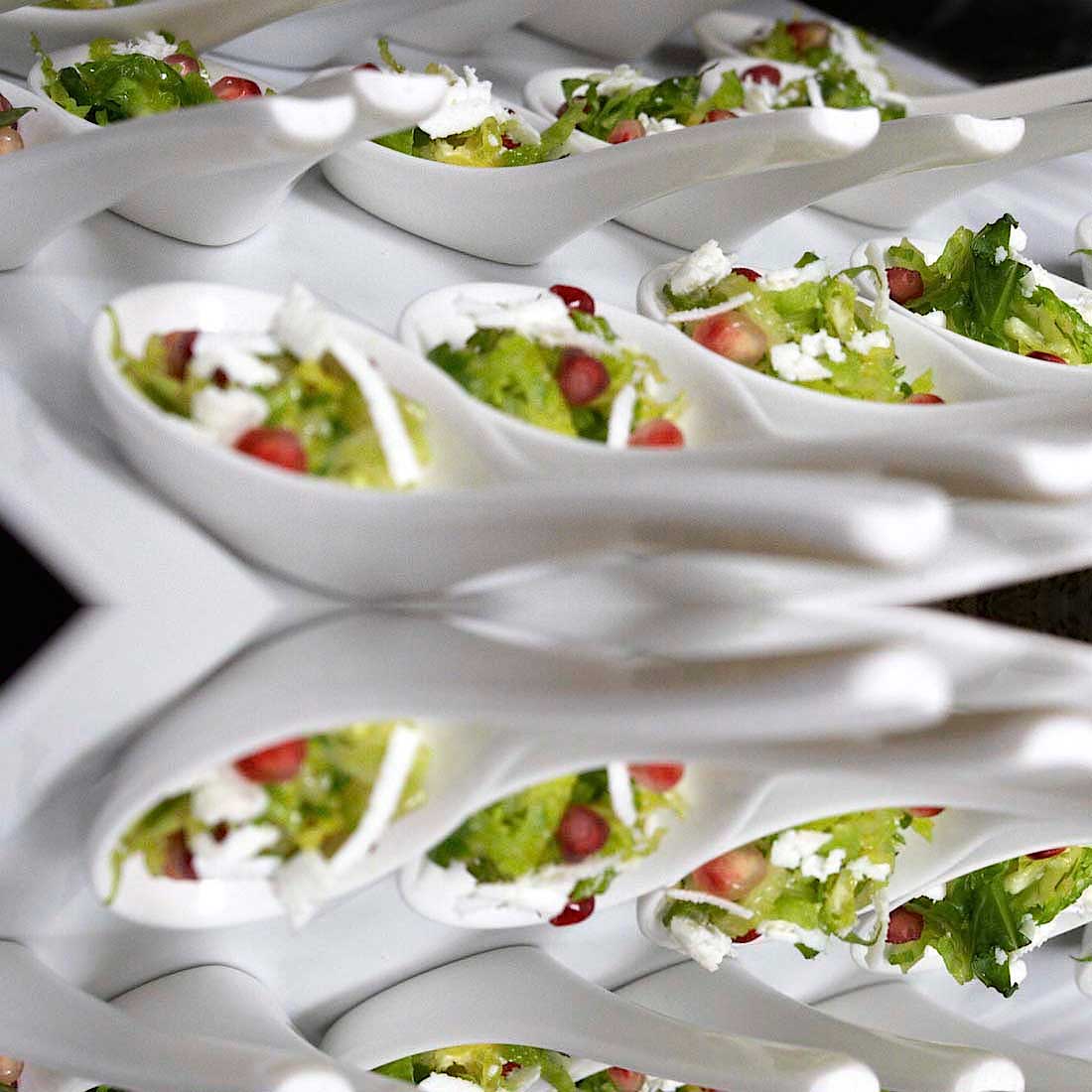
Veteran
patîssière Larissa Raphael is in lock
step with Telepan’s culinary style, offering up
carefully modulated tradition with bright new ideas,
evident in her pineapple upside down cake ($13) with
a terrific brown sugar financier
and coconut ice cream, her buttermilk panna cotta
($14) with colorful rhubarb sorbet, rhubarb soup,
and sesame seed tuile, and her chocolate
crème brûlée ($15) with
chocolate babka bites is tantalizingly rich. If you
order right after you finish your main course, a
ten-minute wait for freshly baked pecan madeleines
is worth it. I
also enjoyed the four well-selected artisanal
American cheeses offered ($22).
Sommelier Sam Clifton does not
just stock a well-balanced wine cellar but does so,
he says, by adding a “seasonal element to better
complement our food and we promote the concept of
drinking and eating in season.”
If Telepan is full just about
every night of the week it is not simply because it
gets a pre-Lincoln Center or Beacon Theater crowd
but because the people who dine here truly love the
restaurant and have come to know what they like and
what Bill Telepan and his staff consistently
provide, which is first-rate, personalized food and
civility. I
used to like Telepan very much, but now I love it
more than ever, and think it ranks with the very
best in New York.
LUNCH
Wednesday to Friday; BRUNCH
Saturday &
Sunday; DINNER nightly
NOTES FROM THE WINE CELLAR
By Mort Hochstein
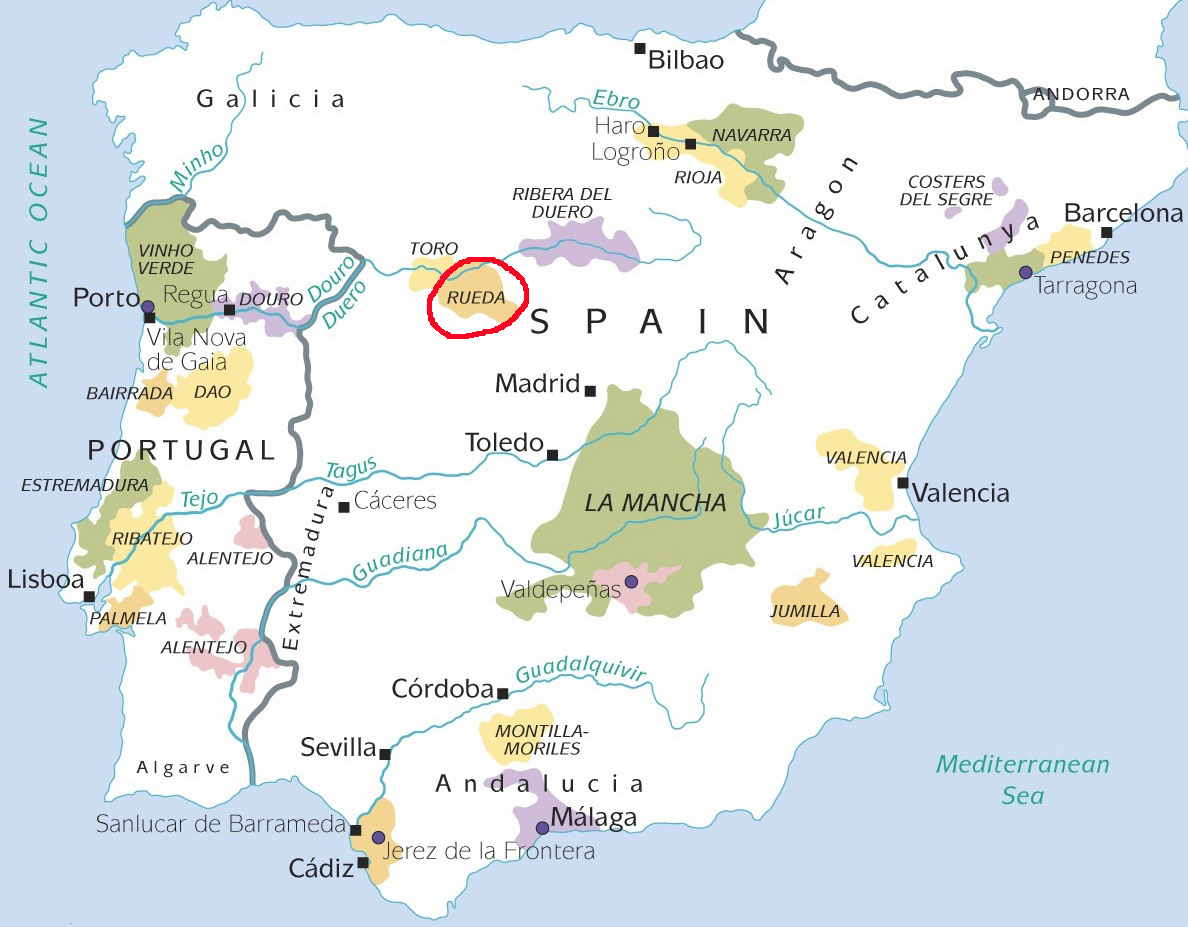 I heard
a wine speech the other day unlike anything I'd
heard before.
I heard
a wine speech the other day unlike anything I'd
heard before.
I was conducting my annual hunt for white
wines for summer drinking and my research
this time around embraced the vineyards of Spain and
Crete.
The speaker, representing the
wines of Rueda, a vineyard area 105 miles
northwest of Madrid, described them as “one
and done, ” meaning
the wines would be best forgotten after one
year from bottling.
It's not the sort of comment you hear from
winemakers who more normally stress ageabiliy. The
speaker was Michael Schachner, who covers Spain and
South America for Wine Enthusiast.
Verdejo (right), a grape unique to the
region, yields
wines that
make for 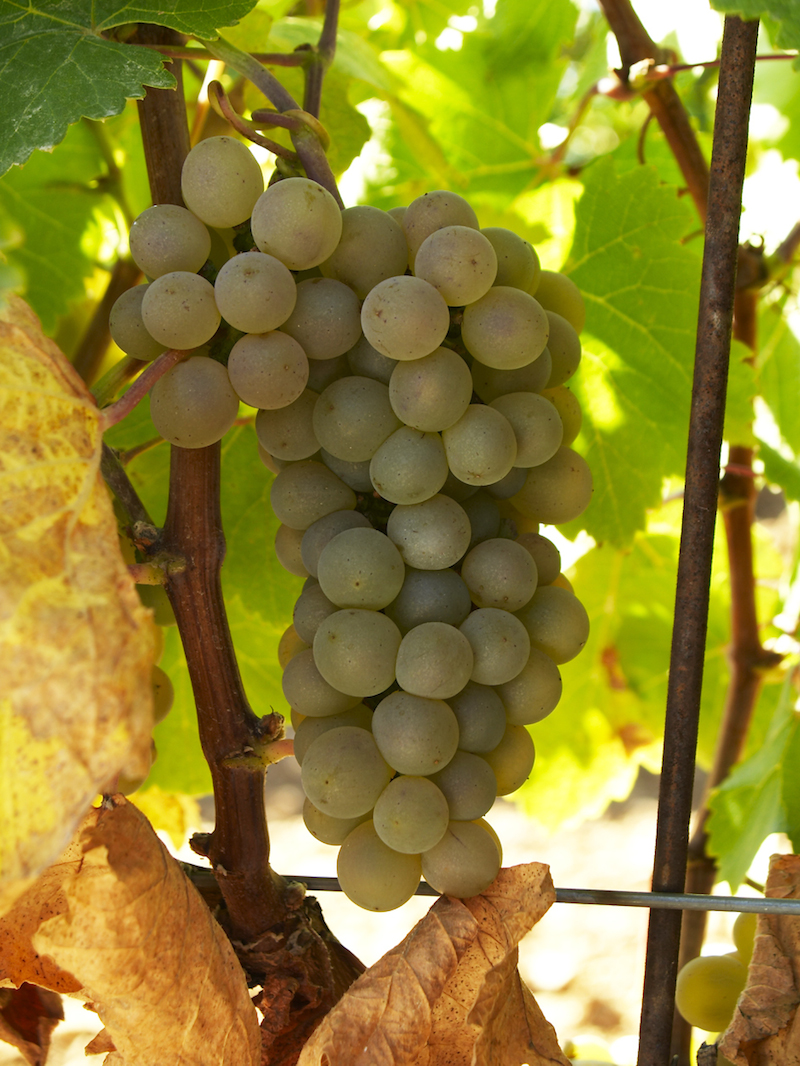 good
quaffing, inexpensive
and unchallenging. Though many of us at the
tasting thought Viño Verde was Spain's
best-selling white wine, we were surprised
to learn that Rueda is actually the nation's
favorite white. These are wines that retail in the
single digit range
up through the $20 level.
good
quaffing, inexpensive
and unchallenging. Though many of us at the
tasting thought Viño Verde was Spain's
best-selling white wine, we were surprised
to learn that Rueda is actually the nation's
favorite white. These are wines that retail in the
single digit range
up through the $20 level.
There
are exceptions to the “one and done” idea. The
majority of the Rueda's are fermented and aged in
steel vats, and the few that go into wood will have
a longer shelf life
as well as a higher, but still moderate price
tag. The wines have a unique flavor, coming from soil
that is rich in calcium and magnesium, stony but
easy to farm, with good ventilation and draining,
and limestone outcrops on the 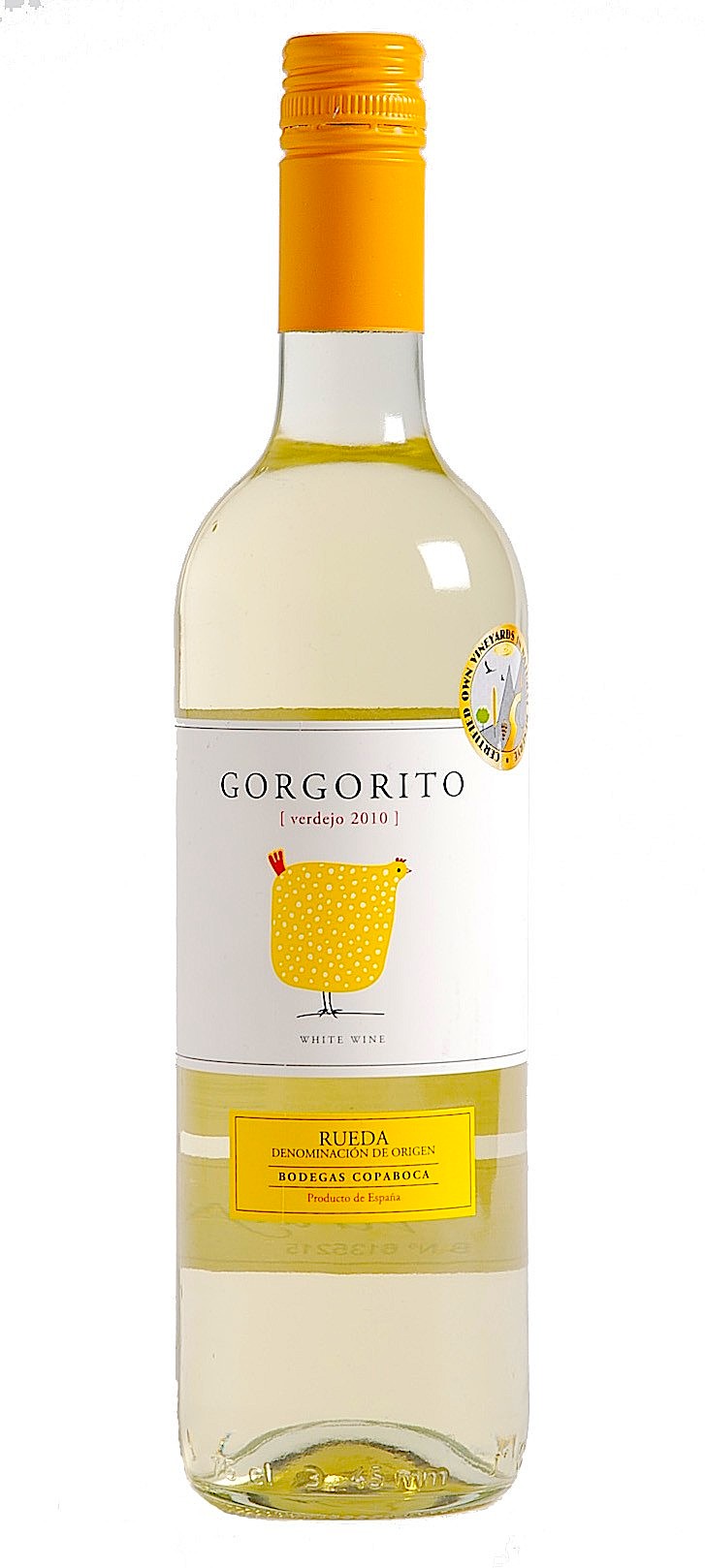 hilltops. The common
definer is good acidity and minerality, cloaked in
citrus scents and flavors. The fruitiness sometimes
carries a tinge of bitterness which gives
the wine even more distinctive character.
hilltops. The common
definer is good acidity and minerality, cloaked in
citrus scents and flavors. The fruitiness sometimes
carries a tinge of bitterness which gives
the wine even more distinctive character.
One of my favorites
was also the simplest, Gorgorito (left) from Bodegas Copaboca
($10.99), almost transparently glass-like in
color, with hints of lemon and grapefruit on the
nose, nicely balanced with delightful minerality.
Light in body and alcohol, it is the very model of a
summer white.
Sauvignon Blanc and Chardonnay are relative
newcomers to Rueda and are often blended with
Verdejo. A growing number of wineries now produce
barrel-fermented white wine, although new barrels
are seldom used. Castelo
de Medina showed as a most pleasant Verdejo
($18) with a bigger body than the norm, which had
more than a year of aging before being bottled.
Labels to seek out are the lemony Montespina Sauvignon
Blanc ($12)
and Campo
Alegre, the most expensive of the lot I
tasted at $30.
❖❖❖
Summering with Old Friends
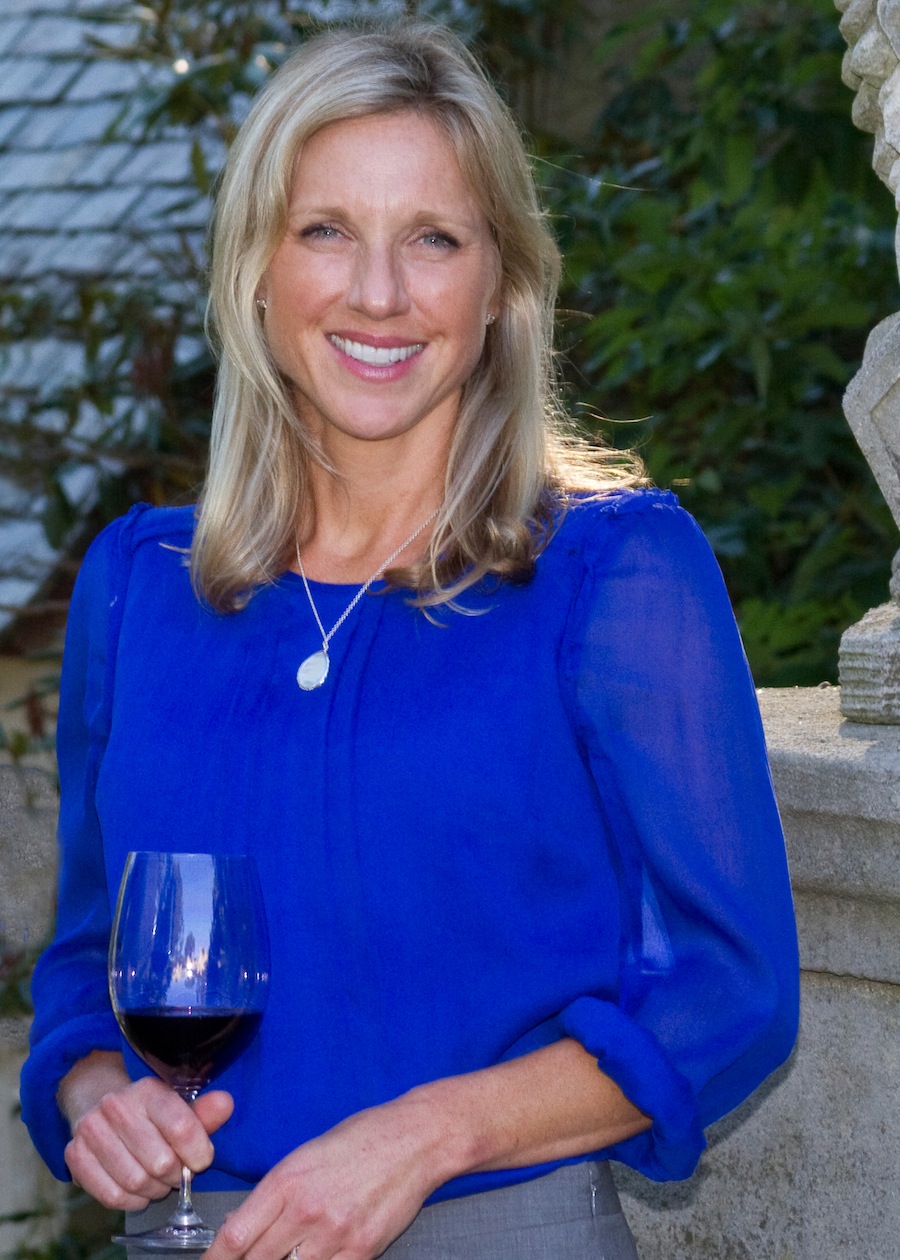
by Cristina Mariani-May
co-CEO of Banfi
Vintners America's
leading wine importer
Warm
weather calls for simple and refreshing wines; light,
breezy, uncomplicated yet satisfying and well made. In the
summer my wine selections are what I like to refer to
as “no brainers,” clear and easy choices. Earlier
this season we talked about some of my favorites from
Tuscany’s coastline and southern hills. Recently
I’ve also gone back to a few favorites especially when
company shows up; these wines are long familiar to the
wine world, but no less interesting for it.
The first is Fontana Candida
Frascati. This
wine hails from just south of Rome, where summers can
be much like ours on the east coast of the US – sunny
and sultry. Likewise, the cuisine of Rome is full of
pepper and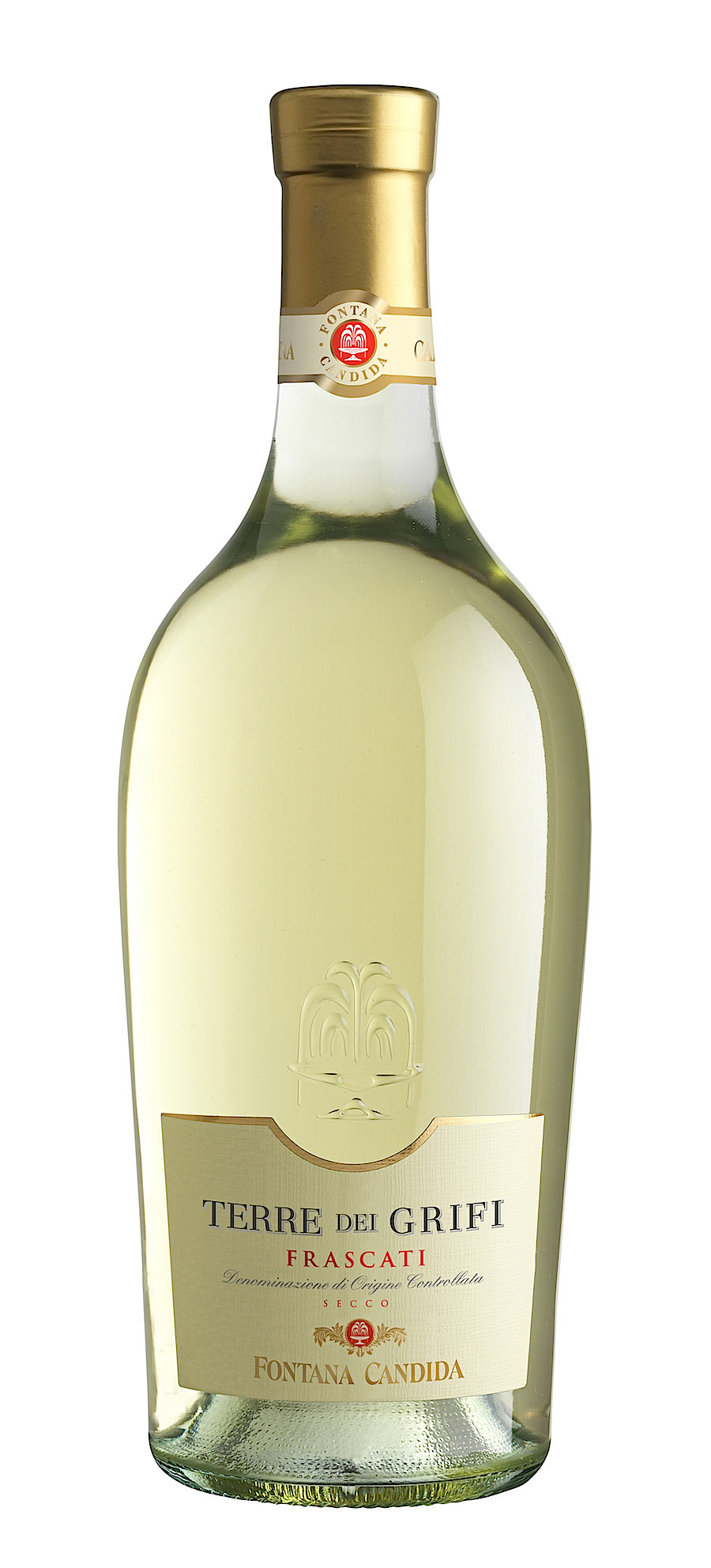 spice, sharp
pronounced flavors that might clash with a heartier
red but find the perfect foil in a flavorful, fruit
forward white. The
name Fontana Candida takes its name from an abundant
fountain in the area, and appropriately so. For years
now, this pristine winery has been turning out a
fountain of very good wine, the kind that charms
visitors to the Eternal City and brings alive the
memories back home.
Like many of my fellow Italians, it is straight
forward and wears its heart on its sleeve. It is
consistently good, always refreshing, and
quintessentially satisfying.
spice, sharp
pronounced flavors that might clash with a heartier
red but find the perfect foil in a flavorful, fruit
forward white. The
name Fontana Candida takes its name from an abundant
fountain in the area, and appropriately so. For years
now, this pristine winery has been turning out a
fountain of very good wine, the kind that charms
visitors to the Eternal City and brings alive the
memories back home.
Like many of my fellow Italians, it is straight
forward and wears its heart on its sleeve. It is
consistently good, always refreshing, and
quintessentially satisfying.
Another blast from the past is
Bolla, and they offer two of my summer sippers. Soave long
ago became synonymous with Bolla, and Soave Bolla
became synonymous with white wine. To many
Americans, Bolla was the first sip of sophistication,
a white wine with noble European heritage yet
appealing to our new world lifestyle in its breezy
way. Fish,
pasta, barbecued chicken, Caesar salad, you name it,
Soave Bolla goes with it. The name seemed to have been
overshadowed for a little while, but recently my
family took a direct interest in resurrecting the
wine’s image and – most especially – its quality, and
the results are showing quite nicely in the glass this
hot summer.
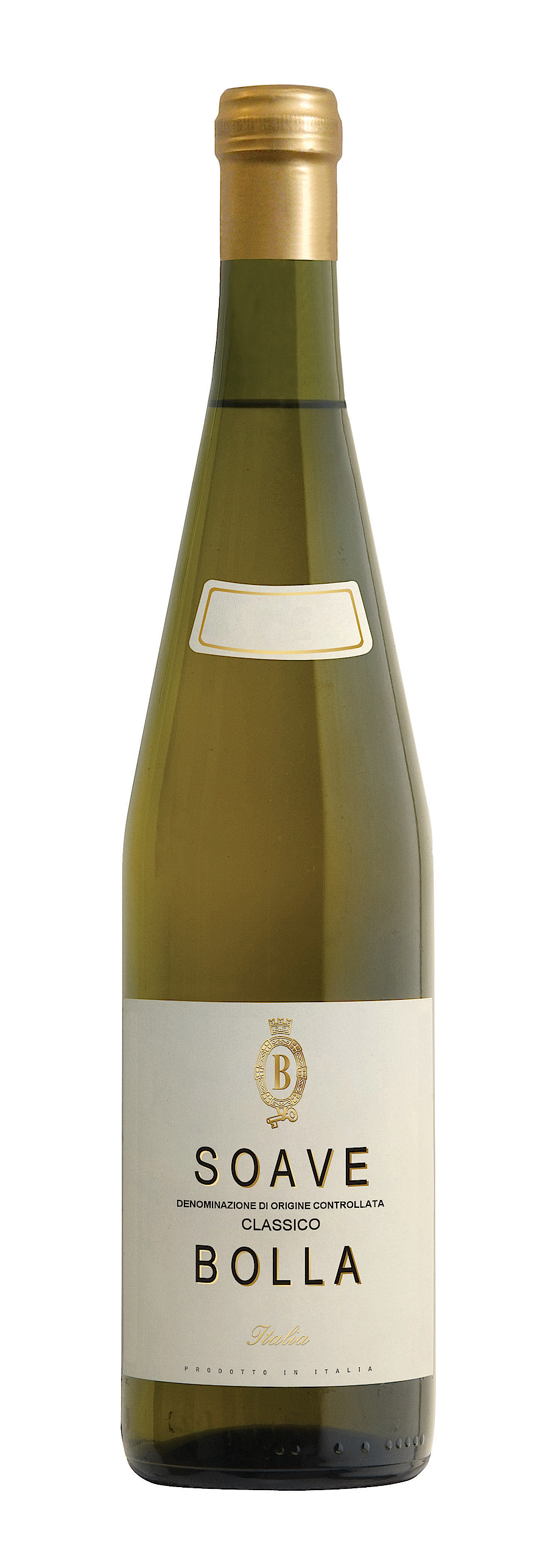 Another fun
summer entry from Bolla is their Bardolino, somewhat
of a sleeper. Younger
sibling to the more popular Valpolicella in the
heirarchy of Veronese wines, Bardolino comes from a
neighboring town and is known for making lighter, less
complex wines – which in my book is good for summer. Sipping a
glassful of chilled Bolla Bardolino is like diving
into a bowl of icy cherries. It feels so right with barbecue,
be it flank steak and London broil or ribs and
burgers, though its supple tannins and gentle acidity
make it a refreshing fit for poolside as well.
Well, right now the kids are in
camp and I’ve got a book calling from my beach chair –
making the choice of which of my favorite wines to
choose the hardest decision of the day. Pretty
cool.
Another fun
summer entry from Bolla is their Bardolino, somewhat
of a sleeper. Younger
sibling to the more popular Valpolicella in the
heirarchy of Veronese wines, Bardolino comes from a
neighboring town and is known for making lighter, less
complex wines – which in my book is good for summer. Sipping a
glassful of chilled Bolla Bardolino is like diving
into a bowl of icy cherries. It feels so right with barbecue,
be it flank steak and London broil or ribs and
burgers, though its supple tannins and gentle acidity
make it a refreshing fit for poolside as well.
Well, right now the kids are in
camp and I’ve got a book calling from my beach chair –
making the choice of which of my favorite wines to
choose the hardest decision of the day. Pretty
cool.
Wines for a
Mid-Summer’s Night – or Day:
Fontana
Candida Frascati – This
ancient wine, born in the Roman hills, has deservedly
been called "the wine of 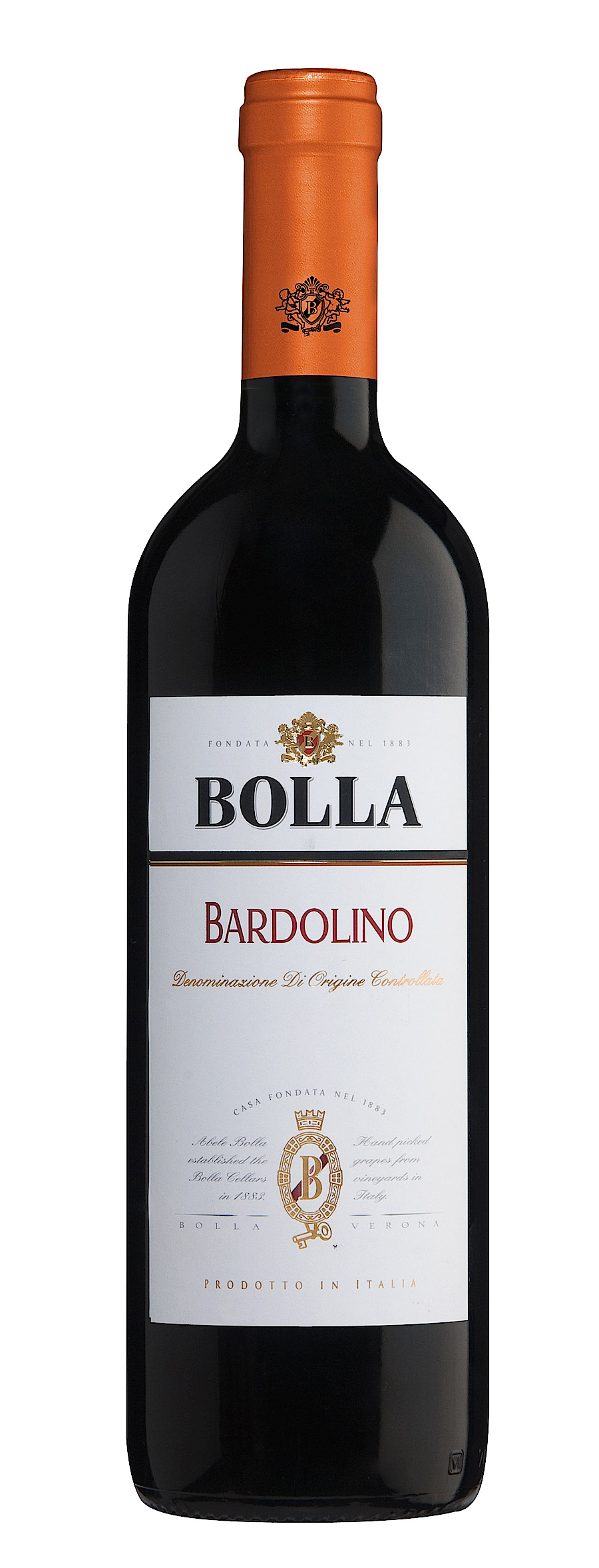 popes and of
the people." Fontana Candida Frascati exhibits a
delicate fragrance of wildflowers with a hint of
Golden Delicious apples. This wine is refreshing and
lively in character. Dry, elegant and soft with notes
of peach and almond on the finish.
popes and of
the people." Fontana Candida Frascati exhibits a
delicate fragrance of wildflowers with a hint of
Golden Delicious apples. This wine is refreshing and
lively in character. Dry, elegant and soft with notes
of peach and almond on the finish.
Bolla
Soave – This
wine is pale yellow in color with green nuances and
has aromas of melon, ripe apple and pear. Trebbiano di
Soave grapes add body and complexity. The finish is
crisp and balanced.
Bolla
Bardolino - The
wine is bright ruby red with hints of black cherry. In
the mouth, the wine is soft and fruit-forward,
followed by a bright and fresh finish. To be served
young.

"Frankly, all you’d have to tell me about a
restaurant to get me in the door would be
`duck-fat fried rice.' How could it not be
delicious?"—Leslie Brenner, Dallas Morning News
(June 4).

AUTHORITIES CHARGED HIM WITH BEING AN UNDERAGE,
SNIVELING LITTLE TWIT
British 15-year-old Digby
Elliott-Berry, whose family is in the brewery
business, began producing his own triple-distilled
juniper- and vanilla-nosed gin with his older
brother and two sisters. "I am a thrill seeker and I
look forward to playing a bigger role as soon as
possible," said the underage-for-drinking inventor,
who named his distillation Sibling Gin, launched in
Gloucestershire last week with a huge gin-and-tonic
party.
Any of John Mariani's
books below may be ordered from amazon.com.
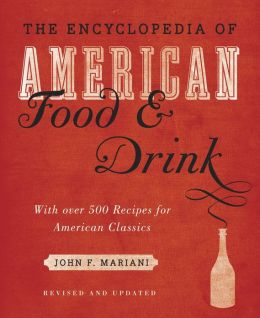 |
The Encyclopedia of American Food and Drink by John F. Mariani (Bloomsbury USA, $35) Modesty forbids me to praise my own new book, but let me proudly say that it is an extensive revision of the 4th edition that appeared more than a decade ago, before locavores, molecular cuisine, modernist cuisine, the Food Network and so much more, now included. Word origins have been completely updated, as have per capita consumption and production stats. Most important, for the first time since publication in the 1980s, the book includes more than 100 biographies of Americans who have changed the way we cook, eat and drink -- from Fannie Farmer and Julia Child to Robert Mondavi and Thomas Keller. "This book is amazing! It has entries for everything from `abalone' to `zwieback,' plus more than 500 recipes for classic American dishes and drinks."--Devra First, The Boston Globe. "Much needed in any kitchen library."--Bon Appetit. |
"Eating Italian will never be the same after reading John Mariani's entertaining and savory gastronomical history of the cuisine of Italy and how it won over appetites worldwide. . . . This book is such a tasteful narrative that it will literally make you hungry for Italian food and arouse your appetite for gastronomical history."--Don Oldenburg, USA Today. "Italian
restaurants--some good, some glitzy--far
outnumber their French rivals. Many of
these establishments are zestfully described
in How Italian Food Conquered the World, an
entertaining and fact-filled chronicle by
food-and-wine correspondent John F.
Mariani."--Aram Bakshian Jr., Wall Street
Journal.
"Equal parts
history, sociology, gastronomy, and just
plain fun, How Italian Food Conquered the
World tells the captivating and delicious
story of the (let's face it) everybody's
favorite cuisine with clarity, verve and
more than one surprise."--Colman Andrews,
editorial director of The Daily
Meal.com. "A fantastic and fascinating
read, covering everything from the influence
of Venice's spice trade to the impact of
Italian immigrants in America and the
evolution of alta cucina. This book will
serve as a terrific resource to anyone
interested in the real story of Italian
food."--Mary Ann Esposito, host of PBS-TV's
Ciao
Italia. "John Mariani has written the
definitive history of how Italians won their
way into our hearts, minds, and
stomachs. It's a story of pleasure over
pomp and taste over technique."--Danny Meyer,
owner of NYC restaurants Union Square
Cafe, The Modern, and Maialino.
|
 |
 |
 |
 |
 |
 |
 |
 |
 Everett Potter's Travel Report:
Everett Potter's Travel Report: 
 Eating Las Vegas
is the new on-line site for Virtual Gourmet
contributor John A. Curtas., who since 1995
has been commenting on the Las Vegas food
scene and reviewing restaurants for Nevada
Public Radio. He is also the
restaurant critic for KLAS TV, Channel 8 in
Las Vegas, and his past reviews can be
accessed at KNPR.org.
Click on the logo below to go directly to
his site.
Eating Las Vegas
is the new on-line site for Virtual Gourmet
contributor John A. Curtas., who since 1995
has been commenting on the Las Vegas food
scene and reviewing restaurants for Nevada
Public Radio. He is also the
restaurant critic for KLAS TV, Channel 8 in
Las Vegas, and his past reviews can be
accessed at KNPR.org.
Click on the logo below to go directly to
his site.

Tennis Resorts Online: A Critical Guide to the World's Best Tennis Resorts and Tennis Camps, published by ROGER COX, who has spent more than two decades writing about tennis travel, including a 17-year stretch for Tennis magazine. He has also written for Arthur Frommer's Budget Travel, New York Magazine, Travel & Leisure, Esquire, Money, USTA Magazine, Men's Journal, and The Robb Report. He has authored two books-The World's Best Tennis Vacations (Stephen Greene Press/Viking Penguin, 1990) and The Best Places to Stay in the Rockies (Houghton Mifflin, 1992 & 1994), and the Melbourne (Australia) chapter to the Wall Street Journal Business Guide to Cities of the Pacific Rim (Fodor's Travel Guides, 1991).


MARIANI'S VIRTUAL GOURMET
NEWSLETTER is published weekly. Editor/Publisher: John
Mariani.
Editor: Walter Bagley. Contributing Writers: Christopher Mariani,
Robert Mariani, John A.
Curtas, Edward Brivio, Mort Hochstein, Suzanne
Wright, and Brian Freedman. Contributing
Photographers: Galina Stepanoff-Dargery,
Bobby Pirillo. Technical Advisor: Gerry McLoughlin.
To un-subscribe from this newsletter,click here.
© copyright John Mariani 2014

